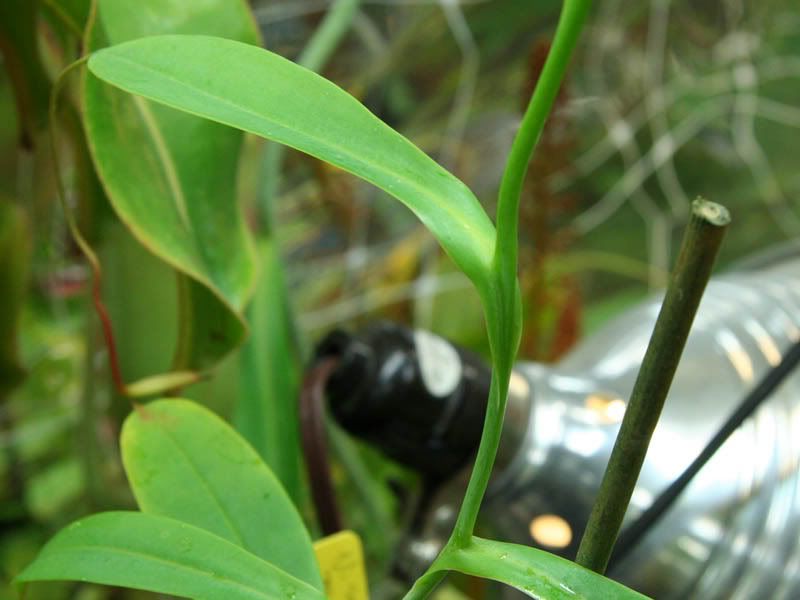|
|
Post by sockhom on Sept 30, 2008 5:02:12 GMT -10
After reviewing the plant closely, I have to say you're right Dave: it is indeed closer to kampotiana than smilesii.
Whatever it is, it's a great new malaysian found . I hope it is an easy grower.
François.
|
|
|
|
Post by Marcello Catalano on Nov 5, 2008 6:40:03 GMT -10
Capslock, come back! The topic is dying here!  The lanceolate shape of the leaf (and lack of evident hair) rules out kongkandana, which grows on the opposite side of the coast. The leaf shape is more similar to smilesii or kampotiana, both growing in a completely different area of the Country (northeast). I would be very interested in knowing what EXACTELY is the indumentum (hair) of this plant. We can see very short hair on tendrils and pitchers. Can you check upper and lower side of the leaf, stem and leaf axil, possibly with a magnifying lens? This plant risks to find itself in the centre of the "Indochina Mess"! Fortunately it's not in Thai territory, I'll ignore it more easily!  Marcello |
|
|
|
Post by capslock on Nov 6, 2008 11:44:03 GMT -10
|
|
Dave Evans
Nobiles
   dpevans_at_rci.rutgers.edu
dpevans_at_rci.rutgers.edu
Posts: 490
|
Post by Dave Evans on Nov 6, 2008 18:22:02 GMT -10
Hello Max and Marcello, It sure does look a lot like N. kampotiana, however there do seem to be some distinctions also: rci.rutgers.edu/~dpevans/Nepenthes/N_kampotiana.htmMy plant has much more decurrent leaf bases, but that might not be so important as this can change somewhat as the plants mature... And mine hasn't gone into upper growth yet. BTW, I dug this plant up and it has a large, lumpy, blackish root stock. It actually looks more like a giant Cephalotus root than what I am used to seeing on a Nepenthes. I noticed what appeared to be four eyes, or possible dormant buds on the very thick upper part of the tuberous rootstock. It seemed different from the rootstock of N. smilesii which had branched with several thickened, brown roots. Max, does this plant also have these different, very thick roots? It took me a couple of years to get back to Marcello about my plant, so no rush.  |
|
|
|
Post by Marcello Catalano on Nov 7, 2008 5:48:03 GMT -10
Ooooh, great photos ! Thanks! Something to talk about! Ok. 1-The leaves are completely glabrous, the indumentum being reduced to tendril and pitcher. 2-the leaves are linear-lanceolate. Of the plants we know, only N. kampotiana has these features. But some differences with kampotiana are obvious here: 1-we are at the opposite side of the Country, in a completely different habitat and altitude, and these species, as far as I know, are quite reduced to specific areas and habitats. 2-those pitchers, so elongated (I mean the lowers shown in the past posts), are not typical of kampotiana, but of other species, like smilesii, kongkandana and various "tigers". Even if with these species pitchers are never a good thing to trust, I've seen kampotiana pitchers identical to kongkandana etc... 3-I noticed like Dave that the leaves are not so decurrent like in the other species of this group. But Dave, be careful, because the decurrency increases a lot when the plant starts vining. Of course we have a flowering plant here, not at the rosette stage, but I would prefer to see some bigger, mature plants in the wild, to see if this "little decurrency" remains. That would be more than enough to say it's a new species. I already think it is. But I'll pass this dream/nightmare to any taxonomist who wants to describe a plant somehow related to the indochina mess  Marcello |
|
|
|
Post by capslock on Jan 10, 2009 10:57:45 GMT -10
Indeed, the plant is now vining with longer internodes, and lo! The decurrency increased dramatically:  Max |
|
|
|
Post by philgreen on Oct 10, 2009 3:36:40 GMT -10
Hi guy's, Sorry to raise an old post (blame Dave, I was looking at his site), but I was wondering if any decissions have been made on the ID of this. It doesn't seem to be in Stewarts new books, so did it just get missed, named, or has it been decided it's part of an existing species and if so which one ? Capslock - how about some updated pic's  |
|
|
|
Post by Marcello Catalano on Oct 10, 2009 5:04:10 GMT -10
I think we'll have to wait a lot before this species is "explained". It's out of my geographic boundary, but inside my taxonomic boundary  Someone with a good knowledge of Thai species should go there and check the plants in the wild. I don't want to be snobbish, it's just that doubtful species by doubtful species, I will end up in Australia!  Limited money and time still decide for my future. This plant has acute tips, it's completely glabrous (these two features being of N. kampotiana), the location is close to N. kongkandana and another new related species, the altitude is the one of N. smilesii (or possibly of the new related species) and the pitchers look like N. smilesii (one lower pitcher, photo in the wild) or something new. So I would say it's a new species, but a much bigger amount of photos of pitchers and whole plant in the wild are needed... one or two plants are not enough with these devils... |
|
nepnut
Urceolatae
 Nuts about Neps
Nuts about Neps
Posts: 18
|
Post by nepnut on Oct 14, 2009 21:43:52 GMT -10
Hmmm... Langkawi is only a few hours from my place... should organize to trip there soon ;D
|
|